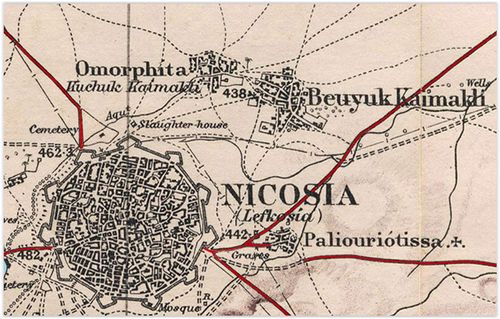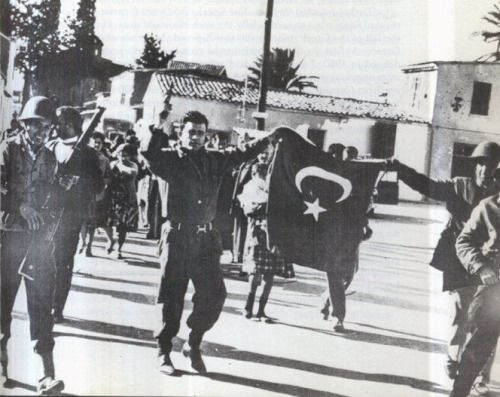Bloody Christmas 1963
Repeated attempts to solve the constitutional disputes failed and the 'eyes and ears' of those in the intelligence community believed that it was "only a matter of time before the balloon went up". The British HQ Cyprus District was briefed accordingly and plans for the defence of the two Sovereign Base Areas and other retained sites were reviewed.
The spark that ignited the explosion of violence happened at 02:30hrs on the 21st December when Greek Cypriot 'special constables' shot dead two Turkish Cypriots who refused to show their identity cards. The incident happened near the Turkish Market in Nicosia and was the outcome of a brawl over prostitutes.

The spot in Nicosia where the two Turkish Cypriots were killed
The funeral of the two Turkish Cypriots took place at 15:00hrs on Sunday 22nd December, an event where calm prevailed, but later that night shooting began in many parts of Nicosia and in other towns and villages across the island (incidents were reported in over 100 villages).
The fighting continued throughout Monday, 23rd and Tuesday 24th December and was especially fierce along the line of the Pedieos River in Nicosia very close to the British High Commission and in the suburb of Omorfita.

Greek Cypriot forces taking up positions near the Turkish Cypriot sector of Nicosia
Image courtesy of the Pachyammos Village Museum

Barricades appear within the walled city.......Greek & Turkish Cypriot

A burnt out property with the Turkish version of the street name painted over
Image by kind permission of Christopher Meynell
The suburb of Omorfita, or Küçük Kaymaklı was, in Kitchener's early maps, a separate village to the north-east of the walled city.

Omorphita (Omorfita) was once a separate village as shown on Kitchener's 1885 survey
Each community has produced its own melodramatic accounts of the December 1963 fighting. The Greek Cypriots believed it was a planned insurection in order to provoke a Turkish military intervention (and therefore partition).
The Turkish Cypriot claim is that it was a deliberate plan to exterminate their community.
Less extravagant versions are that it was to prevent the creation of a large and powerful Turkish enclave that would control access to the Kyrenia District or that the Turkish Cypriots were being frightened into accepting Greek Cypriot political demands.
Whatever viewpoint is accepted, the result of the fighting was that all the Turkish Cypriots from this village/suburb fled their homes.
Robert Stephens in 'Cyprus - A place of Arms' describes the fighting as follows........
"Greek Cypriot security forces, police and armed irregulars, mostly ex-EOKA, launched a massive counter-attack on the Turkish Cypriot positions in Nicosia.
Greek Cypriots in the mixed suburb of Omorphita had been surrounded and sent out an SOS for help. The Greek Cypriot forces used their full strength to break the siege. They captured the Turkish Cypriot positions and the irregulars ran wild, killing scores of Turkish Cypriots, including women and children, smashing and looting homes and taking hundreds of hostages."

Nikos Sampson (an EOKA fighter sentenced to death by the British....but later commuted) displays a captured Turkish flag following the fighting in the village of Omorfita..........behind him are a large group of Turkish Cypriot hostages (mostly women & children)

Burnt out property in Omorfita.......a result of the fierce fighting
Image by kind permission of Christopher Meynell
Christmas Day saw little let up in the fighting with the first incidents reported at 00:01hrs. After a short respite in Nicosia, the fighting began again at 10:00hrs.
Greek Cypriot forces occupied and fortified the Cornaro Hotel making the nearby High Commission barely tenable.
At midday, two Turkish Airforce F-104 Starfighters overflew Nicosia at very low level. Ninety minutes later this action was repeated by three F-100 Super Sabres.

A bulldozer converted to a tank by Greek Cypriot forces and used in "mopping up" operations in Omorfita
The crisis deepened when there were reports that the previously quiet Turkish Cypriot sector of Limassol was surrounded and under attack from Greek Cypriot forces.
Turkish warships were reported off Kyrenia and it seemed that Turkey was intent on exercising her treaty rights to intervene militarily to protect the rights of the Turkish Cypriots (Treaty of Guarantee).
By evening of the 25th December, the C-in-C British Forces (Air Chief Marshal Sir Denis Barnett) and the GOC (Major General Peter Young) decided to fly to RAF Nicosia on the 26th December for discussions with the British High Commissioner.